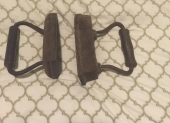People never really knew why their (iron/steel) stove pipe liners on their burn chamber don't last very long, but I think I do.
I recently did a one-day intensive blacksmithing introduction workshop, and one of the interesting things that I noticed was that every single time we put our piece of metal into the forge to heat it up, it came out with scale. scale is basically rust, but it forms practically instantly and is just part of blacksmithing. You lose some percentage of the material every single time you heat it up do this oxidation, and when you hammer, it just falls right off. It's usually very thin, like a sheet of paper, and flaky. It only forms above a certain temperature. Some knife makers want a nice smooth finish, so they will heat up their work, brush off the scale until the metal is below that temperature (and thus stops forming scale), and then hammer away as usual. Hammering with the scale intact leaves a small depression on the surface, preventing a smooth finish. Kindof like if you put a coin on top of some clay, and then hammer away at that - even after you remove the coin and hammer some more, it leaves an impression.
I looked up what temperature scale forms at from
http://www.blksmth.com/heat_colors.htm -
1400F / 760C - SCALE FORMS AND ADHERES TO IRON, MILD STEEL
1750F / 955 C - SCALE FALLS OFF IRON FREELY
So rusting is normally accelerated with temperature, but when you reach these high temps, it gets WAY faster. Almost what you'd call "instant". Cast iron still creates scale (the flaky stuff in the bottom of your skillet looks just like scale), but it's so thick compared to sheet metal that it takes a lot longer to rust through. That's why pellet stove burn pots are made from cast iron - so they last longer than a few months.








